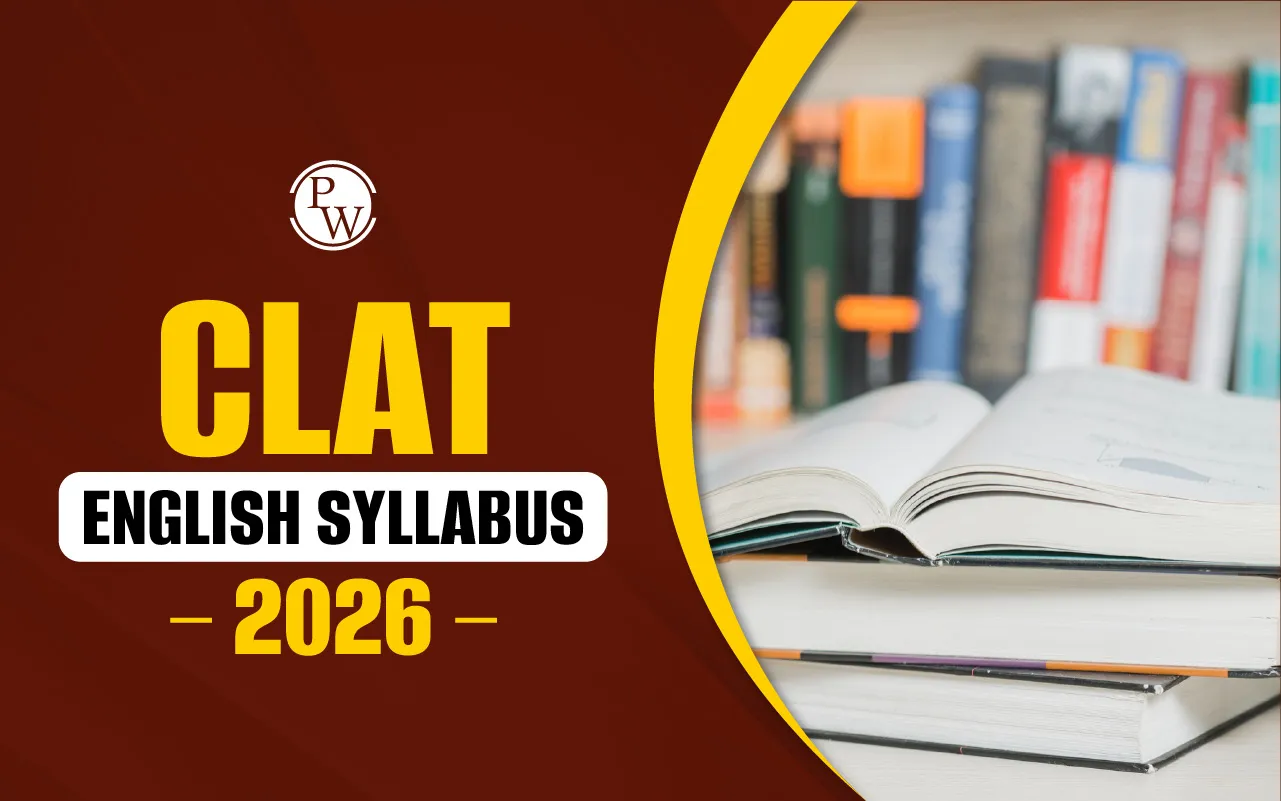

CLAT English Syllabus 2026 focuses on testing a candidate’s reading and comprehension skills through passage-based questions. The section includes 3–4 passages of about 450 words each taken from contemporary and classic fiction or non-fiction texts.
The questions aim to evaluate a student’s ability to understand the main idea, draw inferences, interpret meanings of words and phrases, and summarise information accurately. Designed at a Class 12 level, the English section carries 20% weightage in the overall CLAT paper. The Consortium of National Law Universities will conduct the CLAT 2026 exam on December 7, 2025 in offline mode. Candidates are advised to prepare by reading newspapers, practicing comprehension passages, and improving their vocabulary to perform well in this crucial section.
CLAT English Syllabus 2026 Overview
CLAT English Syllabus 2026 tests candidates' ability to read, understand and interpret passages drawn from various sources. It also measures vocabulary, comprehension and critical thinking skills needed for legal studies.
|
CLAT English Syllabus 2026 Overview |
|
|
Particulars |
Details |
|
Exam Name |
Common Law Admission Test (CLAT) 2026 |
|
Conducting Body |
Consortium of National Law Universities (NLUs) |
|
Exam Date |
December 7, 2025 |
|
Mode of Exam |
Offline (Pen and Paper) |
|
Section Name |
English Language |
|
Section Weightage |
20% of total marks |
|
Number of Questions |
22–26 |
|
Type of Questions |
Passage-based Multiple Choice Questions (MCQs) |
|
Passage Length |
Around 450 words each |
|
Source of Passages |
Contemporary or historically significant fiction and non-fiction texts |
|
Difficulty Level |
Class 12 level |
|
Skills Tested |
Reading comprehension, inference, vocabulary, summarising and understanding arguments |
Topics Covered in English Syllabus for CLAT 2026
English section of CLAT 2026 covers a variety of topics that test a candidate reading comprehension and language skills. Below is a list of the key topics included in the CLAT English syllabus 2026
|
Topics Covered in English Syllabus for CLAT 2026 |
||
|
S.No. |
Topics Covered |
Description |
|
1 |
Synonyms and Antonyms |
Questions to test knowledge of similar and opposite words. |
|
2 |
Identifying Word Meanings and Phrases |
Understanding meanings and phrases used within the passage. |
|
3 |
Drawing Inferences and Conclusions |
Interpreting and concluding ideas based on the given passage. |
|
4 |
Summarising the Passage |
Condensing the passage into a short summary while retaining key points. |
|
5 |
Understanding Words in Context |
Analyzing how words and phrases are used in a specific context. |
|
6 |
Direct Questions from the Passage |
Answering factual questions directly based on the passage content. |
CLAT 2026 English Syllabus Details
CLAT 2026 English syllabus focuses on testing a candidate reading comprehension, interpretation, and analytical skills through passage-based questions. The section includes 3–4 passages each around 450 words long taken mainly from journalistic and non-fictional sources. Each passage is followed by multiple-choice questions that test how well the candidate understands the content, context, and arguments presented.
In total the CLAT English section contains around 22–26 questions and the difficulty level is set at Class 12 standard similar to the other sections of CLAT except Mathematics which is of Class 10 level.
What Type of English is Asked in CLAT?
The English in CLAT is comprehension-based not grammar-focused. Passages are drawn from newspapers, magazines and non-fiction texts and candidates must answer questions that assess their understanding, vocabulary and reasoning based on the passage content.
What Does CLAT English Syllabus 2026 Evaluate?
The English section evaluates overall English proficiency and skills that are also important for other parts of the CLAT exam. Since CLAT is a reading-intensive test this section checks the ability to process and analyze complex texts. The CLAT 2026 English syllabus tests the candidate ability to:
-
Read and understand the main idea of the passage and the opinions or arguments expressed.
-
Draw inferences and conclusions based on the given information.
-
Summarise lengthy passages effectively.
-
Evaluate and compare different arguments presented in the text.
-
Understand the meanings of words and phrases in their given context.
Analysis of CLAT English Syllabus 2026 of Previous Years
The analysis of the CLAT English syllabus 2026 based on previous years papers helps candidates understand the question trends and difficulty levels. It also helps candidates understand the types of topics and question formats that commonly appear in the exam.
|
Analysis of CLAT English Syllabus 2026 of Previous Years |
||
|
Year |
Topics Covered |
Difficulty Level |
|
2025 |
Passage-based questions focusing on comprehension, synonyms, and antonyms. No questions on grammar usage. |
Easy |
|
2024 |
Literature-based passages with direct questions based on information from the paragraph. No vocabulary-based questions. |
Easy |
|
2023 |
Questions on drawing inferences, identifying sentence meanings in context, and vocabulary-based questions. |
Easy but lengthy |
How to Prepare for CLAT 2026 English Syllabus?
Preparing for the CLAT 2026 English syllabus requires consistent reading, strong vocabulary and regular practice. Since the section focuses on comprehension and interpretation, candidates should work on improving their reading speed and accuracy. Below are effective tips to help you prepare well for the CLAT English section:
-
Read daily – Make a habit of reading newspapers, editorials and magazines to enhance your comprehension skills and stay updated with current events.
-
Build vocabulary – Use flashcards, dictionaries or books to learn new words and improve your understanding of their usage.
-
Practice passages – Solve previous year CLAT English passages and sample papers to get used to the question pattern and difficulty level.
-
Focus on comprehension – Practice summarising long paragraphs and identifying main ideas to improve your analytical reading ability.
-
Analyze mock tests – Attempt regular mock tests to identify weak areas and work on improving speed and accuracy before the final exam.
